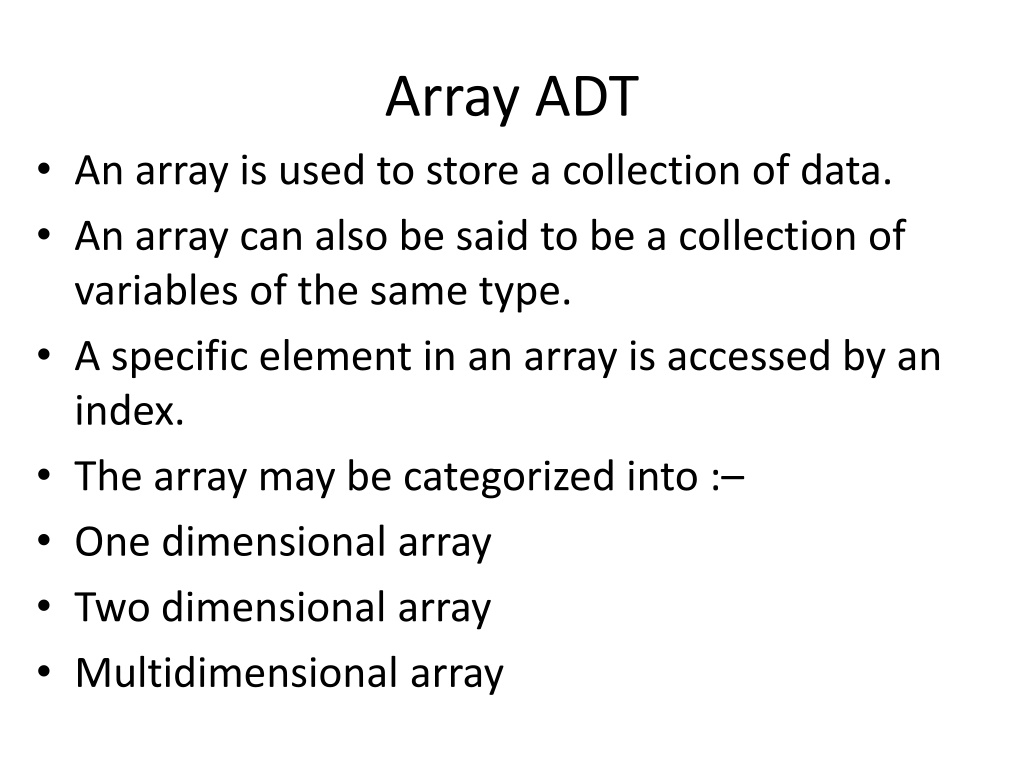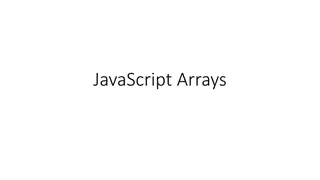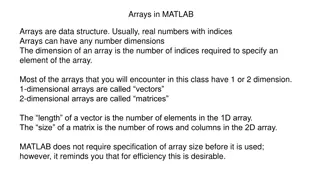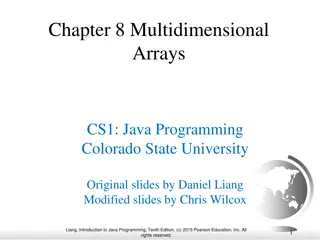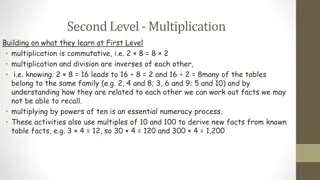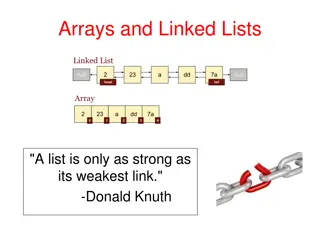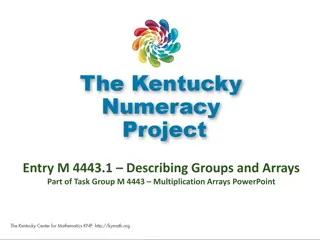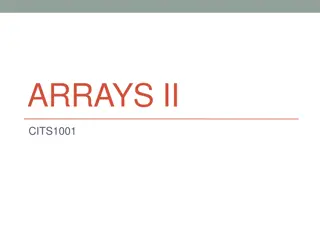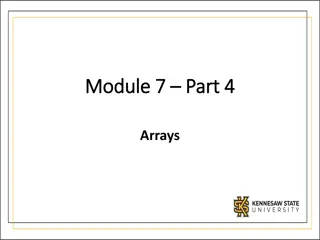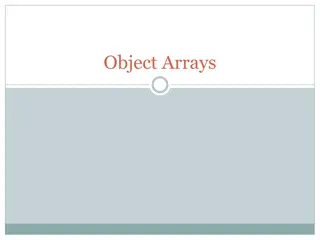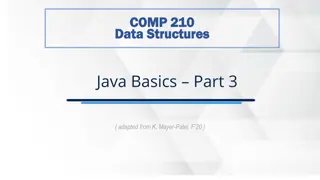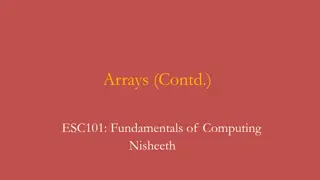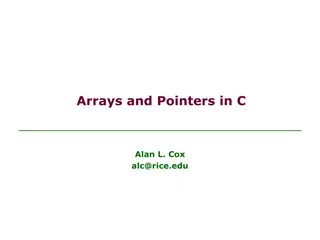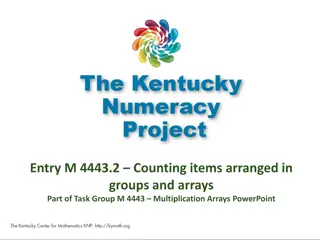Understanding Arrays: Overview and Examples
Arrays are essential data structures used to store collections of data in programming. They can be one-dimensional, two-dimensional, or multidimensional, accessed by specific indices. Learn about linear arrays, indexing methods, and two-dimensional arrays through detailed explanations and visual representations.
Download Presentation

Please find below an Image/Link to download the presentation.
The content on the website is provided AS IS for your information and personal use only. It may not be sold, licensed, or shared on other websites without obtaining consent from the author. Download presentation by click this link. If you encounter any issues during the download, it is possible that the publisher has removed the file from their server.
E N D
Presentation Transcript
Array ADT An array is used to store a collection of data. An array can also be said to be a collection of variables of the same type. A specific element in an array is accessed by an index. The array may be categorized into : One dimensional array Two dimensional array Multidimensional array
Linear Array (or one dimensional array) is the simplest type of data structure. It is a list of a finite number n of similar data referenced respectively by a set of n consecutive numbers, usually 1, 2, 3 . . . . . . . n. if we choose the name A for the array, then the elements of A are denoted by subscript notation A 1, A 2, A 3 . . . . A n or by the parenthesis notation A (1), A (2), A (3) . . . . . . A (n) or by the bracket notation A [1], A [2], A [3] . . . . . . A [n]
There are three ways in which the elements of an array can be indexed: 0 (zero-based indexing): The first element of the array is indexed by subscript of 0. 1 (one-based indexing): The first element of the array is indexed by subscript of 1. n (n-based indexing): The base index of an array can be freely chosen. Usually programming languages allowing n-based indexing also allow negative index values and other scalar data types like enumerations, or characters may be used as an array index.
Example: A linear array A[8] consisting of numbers is pictured in following figure. 1 2 3 4 5 6 7 8 A[0] A[1] A[2] A[3] A[4] A[5] A[6] A[7] int A[8] = {1,2,3,4,5,6,7,8} Representation of one-dimensional array Defining array: array [1 .N] of integer In order to locate the address of a given array, i is the index of an array that is to be located and B is the Base Address (the first location of individual address}, where N is the last number of an array also represented as X.
The following formula is used to locate address of one dimensional array Location(X[I]) = BA + (i 1) For example: Given one dimensional array of 8 integers, locate the address of the fifth element, if BA is 300. Solution BA = 300, i = 5 Location(X[5]) = 300 + (5 1) = 300 + 4 = 304 The address of element of fifth element is 304 since address of the first element is 300.
Two-Dimensional Arrays The simplest form of the multidimensional array is the two-dimensional array. A two dimensional array is a list of one- dimensional arrays. To declare a two-dimensional integer array of size x,y you would write something as follows: type arrayName [ x ][ y ]; i.e. int a[1][2] A two-dimensional array can be think of as a table which will have x number of rows and y number of columns
A 2-dimensional array a, which contains three rows and four columns can be shown as below: Thus, every element in array a is identified by an element name of the form a[ i ][ j ], where a is the name of the array, and i and j are the subscripts that uniquely identify each element in a.
Representation of two dimensional arrays in memory A two dimensional m x n Array A is the collection of m X n elements stores in one dimensional memory in either of two ways: Row Major Order: First row of the array occupies the first set of memory locations reserved for the array; Second row occupies the next set, and so forth.
(0,0) (0,1) (0,2) (1,0) (1,1) (1,2) (2,0) (2,1) (2,2)
To determine element address A[i,j]: Location ( A[ i,j ] ) =Base Address + ( N x ( I - 1 ) ) + ( j - 1 ) For example: Given an array [1 5,1 7] of integers. Calculate address of element A[4,6], where BA=900. Solution I = 4 , J = 6, M= 5 , N= 7 Location (A [4,6]) = BA + (7 x (4-1)) + (6-1) = 900+ (7 x 3) +5 = 900+ 21+5 = 926
Column Major Order: Order elements of first column stored linearly and then comes elements of next column. (0,0) (0,1) (0,2) (1,0) (1,1) (1,2) (2,0) (2,1) (2,2)
To determine element address A[i,j]: Location ( A[ i,j ] ) =Base Address + ( M x ( j - 1 ) ) + ( i - 1 ) For example: Given an array [1 6,1 8] of integers. Calculate address element A[5,7], where BA=300. Solution I = 5 , J = 7, M= 6 , N= 8 Location (A [4,6]) = BA + (6 x (7-1)) + (5-1) = 300+ (6 x 6) +4 = 300+ 36+4 = 340
Representation of Three& Four Dimensional Array By the same way we can determine address of element for three and four dimensional array: Three Dimensional Array To calculate address of element X[ i,j,k] using row-major order : Location (X[i,j,k])=BA + MN (k-1) + N (i-1) + (j-1) using column-major order Location (X[i,j,k])=BA + MN (k-1) + M (j-1) + (i-1)
Four Dimensional Array To calculate address of element X[ i,j,k] using row- major order : Location ( Y[i,j,k,l] )=BA + MNR (l-1) +MN (k-1) +N (i-1) + (j-1) using column-major order Location ( Y[i,j,k,l] )=BA + MNR (l-1) +MN (k-1) +M (j-1) + (i-1)
For example: Given an array [ 1..8, 1..5, 1..7 ] of integers. Calculate address of element A[5,3,6], by using rows &columns methods, if BA=900? Solution The dimensions of A are: M=8, N=5, R=7, i=5, j=3, k=6, BA=900. Rows- wise Location (A[i,j,k]) = BA + MN(k-1) + N(i-1) + (j-1) Location (A[5,3,6]) = 900 + 8x5(6-1) + 5(5-1) + (3-1) = 900 + 40 x 5 +5 x 4 + 2 = 900 + 200 +20 +2 = 1122
Columns- wise Location (A[i,j,k]) = BA + MN(k-1) + M(j-1) + (i-1) Location (A[5,3,6]) = 900 + 8x5(6-1) + 8(3-1) + (5-1) = 900 + 40 x 5 +8 x 2 + 4 = 900 + 200 +16 +4 = 1120
Assignments 2 Given an array A [1 7, 3 9, 2 8], calculate the address of element A[4,5] by using rows and columns method, if Base Address is 900. Given an array A [3...6, 2 5, 3 6], calculate the address of element A[2,4,3] by using rows and columns method, if Base Address is 50. Given an array A [2...4, 1 3, 3 5], calculate the address of element A[2,1,3,5] by using rows and columns method, if Base Address is 100.
Operations on Array Traversing: means to visit all the elements of the array in an operation is called traversing. Insertion: means to put values into an array Deletion / Remove: to delete a value from an array. Sorting: Re-arrangement of values in an array in a specific order (Ascending or Descending) is called sorting. Searching: The process of finding the location of a particular element in an array is called searching.
Sorting in Linear Array: Sorting an array is the ordering the array elements in ascending (increasing from min to max) or descending (decreasing from max to min) order. Bubble Sort: The technique that is used is called Bubble Sort because the bigger value gradually bubbles their way up to the top of array like air bubble rising in water, while the small values sink to the bottom of array. This technique is to make several passes through the array. On each pass, successive pairs of elements are compared. If a pair is in increasing order (or the values are identical), the values are left as they are. If a pair is in decreasing order, their values are swapped in the array.
Applications of Array Arrays are used to implement mathematical vectors and matrices, as well as other kinds of rectangular tables. Many databases, small and large, consist of (or include) one-dimensional arrays whose elements are records. Arrays are used to implement other data structures, such as heaps, hash tables, dequeues, queues, stacks, and strings. Arrays can be used to determine partial or complete control flow in programs, as a compact alternative to (otherwise repetitive) multiple IF statements.
Assignments 3 Using Bubble Sort techniques, sort the following array {5, 2, 7,1, 3, 6} in a three pass. Bubble Sort the following array {7,3,1,5, 4} in an ascending and descending order Using Bubble Sort techniques, sort the following array {6, 7,8,4, 2,3, 1, 5} in a six pass. In a tabular form differentiate between dynamic and static memory allocation.
Linear List A linear list is arranged in one dimensional array. Operations on Linear List The following operations can be performed on linear list: Add: elements can be added to linear list Set: a particular elements in linear list can be replaced by another or overwritten by another. Remove: a particular elements in linear list can be deleted Get: an elements in linear list can be retrieved.
Supposing COMPUTER is a list called L that is arranged in a one dimensional array: perform the following operations on the list; i. Add (5,D,L) iii. Remove (R,L) ii. Set (4,I,L) iv. Get(3,L) Add(5,D,L) Before C O M P U T E R After C O M P U D T E R
Set (4,I,L) Before C O M P U D T E R After C O M P I D T E R Remove (R,L) Before C O M P I D T E R After C O M P I D T E Get(3,L) returns the value of the third node = P
Assignment 4 Supposing SOCIOLOGY is a list called L that is arranged in a one dimensional array: perform the following operations on the list; i. Set (4,U,L) iii. Get(5,L) ii. Add (2,D,L) iv. Remove (L,L) Supposing ASSIGNMENT is a list called L that is arranged in a one dimensional array: perform the following operations on the list; i. Remove(G,L) iii. Add (9,S,L) ii. Get (3,L) iv. Set (6,P,L)
Linked List Data Structure A linked list or one way list is a linear collection of data elements, called nodes, where the linear order is given by means of pointers . Each node is divided into two parts. The first part contains the information of the element. The second part called the link field contains the address of the next node in the list. This is an example of linked list:
The Head is a special pointer variable which contains the address of the first node of the list. If there is no node available in the list then Head contains NULL value meaning that, List is empty. The left part of the each node represents the information part of the node, which may contain an entire record of data (e.g. ID, name, marks, age etc). The right part represents pointer/link to he next node. The next pointer of the last node is null pointer signal the end of the list.
Types of linked lists Singly linked list: it begins with a pointer to the first node; it terminates with a null pointer and traverse is in one direction. Circular, singly linked: it has pointer in the last node points back to the first node
Doubly linked list: it has two start pointers first element and last element; each node has a forward pointer and a backward pointer, it allows traversals both forwards and backwards Circular, doubly linked list: has forward pointer of the last node points to the first node and backward pointer of the first node points to the last node.
Header Linked List: this linked list contains a header node that contains information regarding complete linked list. The Operations on the Linear Lists Various operations on linear lists are: Search: This operation involves the searching of an element in the linked list. Additional (Inserting): To add new node to data structure. Deletion: To delete a node from data structure. Merge: To merge two structures or more to constituting one structure. Split: To divide data structure to two structures or more. Counting: counting some of items or nodes in data structure. Copying: copy data of data structure to another data structure. Sort: sort items or nodes in data structure according to the value of the field or set of fields. Access: To access from node or item to another one may be need some of purposes to test or change
Comparison of Linked List and Array Comparison between array and linked list are summarized in following table: S/N Array Linked List 1. List of elements stored in contiguous memory location i.e. all elements are linked physically List of elements need not stored in contiguous memory location i.e. all elements will be linked logically. 2. There is large requirements of contiguous memory required for complete list There is small requirements of contiguous memory required for complete list 3. List is static in nature i.e. created at compile time mostly List is dynamic in nature i.e. created and manipulated at execution time 4. List cannot grow and shrink List can grow and shrink dynamically
S/N Array Linked List 5. Memory allocate d to single item of list cannot be free Memory allocate d to single node of list can be free 6. Traversal is easy since any elements can be accessed dynamically and randomly Traversal is done node by node, hence not as good as in array 7. Searching can be linear and if sorted than in array we can also apply binary sear of algorithm time complexity Searching operation must be linear in case of sorted list also. Time complexity is proportional to list length 8. Insertion/deletion is costly since shifting of many items is required. Insertion/deletion is performed by simple pointer exchange. Only set of pointer assignment statements can perform insertion /deletion operation.
